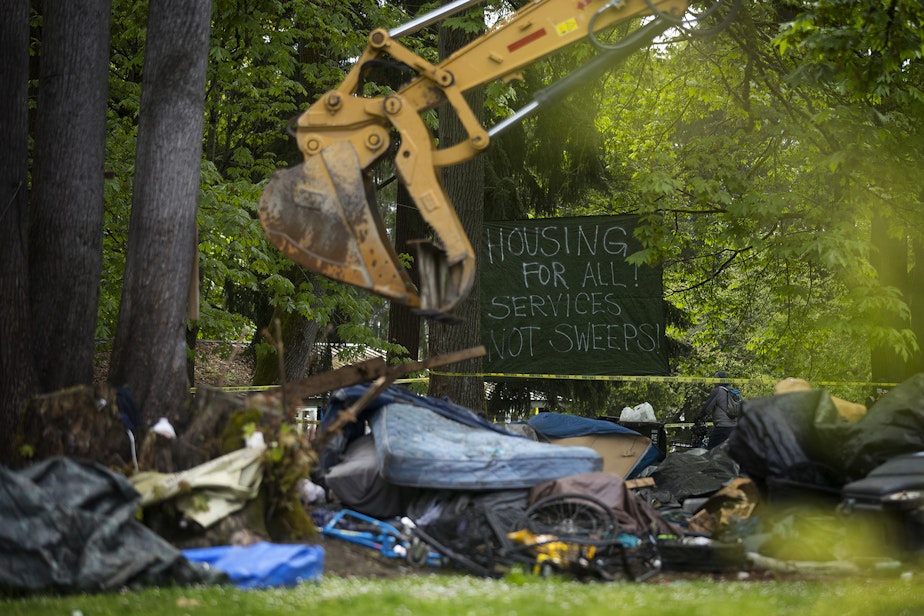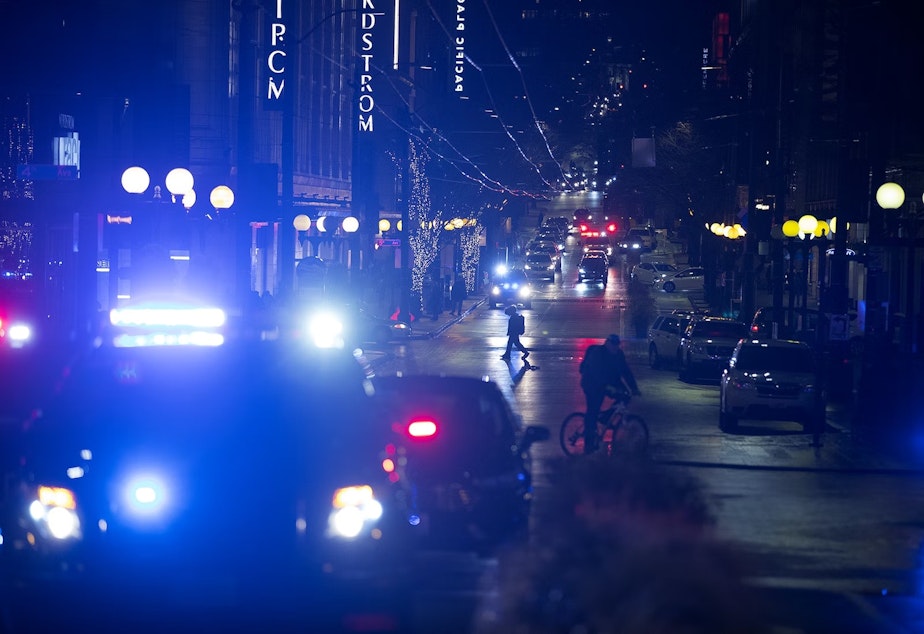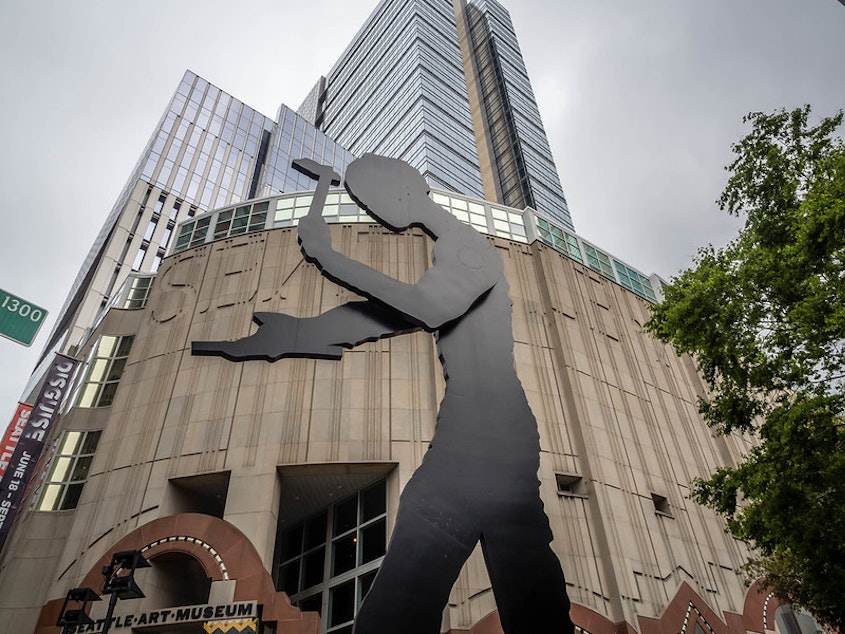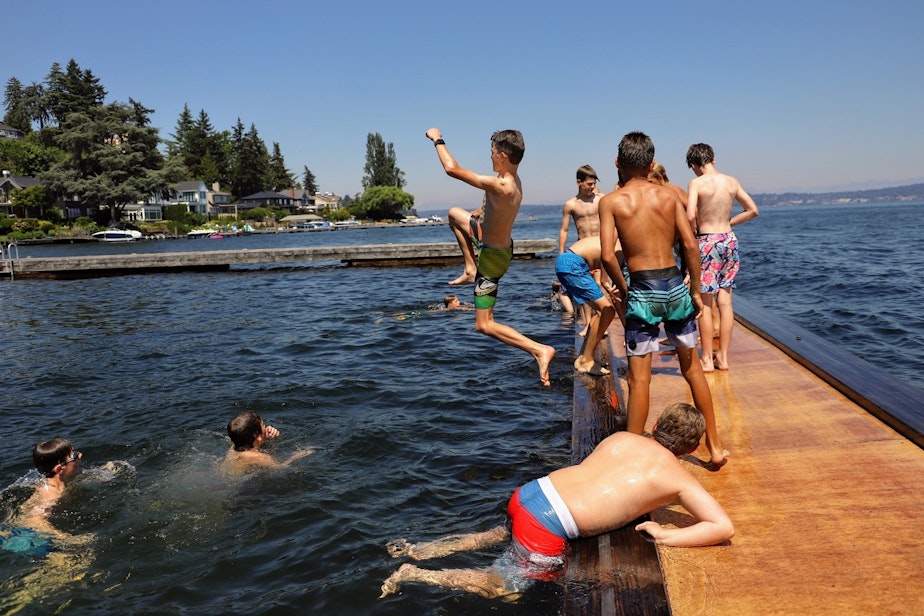

KUOW Blog
News, factoids, and insights from KUOW's newsroom. And maybe some peeks behind the scenes. Check back daily for updates.
Have any leads or feedback for the KUOW Blog? Contact Dyer Oxley at dyer@kuow.org.
Stories
-
Does the US Supreme Court ruling on public camping bans criminalize homelessness?
Law & Courts
 The city of Seattle removed unhoused people and their belongings from an encampment on Tuesday, May 10, 2022, at Woodland Park in Seattle. The U.S. Supreme Court ruled Friday that cities can ban public sleeping and camping.
The city of Seattle removed unhoused people and their belongings from an encampment on Tuesday, May 10, 2022, at Woodland Park in Seattle. The U.S. Supreme Court ruled Friday that cities can ban public sleeping and camping.The U.S. Supreme Court ruled Friday that cities can ban camping and sleeping in public, even if there is no shelter to send them to, overturning a previous ruling that has guided cities' approaches to homelessness for years.
Seattle was among the cities seeking the Supreme Court's decision this week.
"Today’s ruling makes it clear that determining policy to address homelessness is a task for locally elected leaders,” Seattle City Attorney Ann Davison said in a statement. “This decision emphasizes the importance of local authority."
In recent years, local policies around whether public sleeping or camping can be banned have centered on the Eighth Amendment, which bars cruel and unusual punishment. A 2018 U.S. Court of Appeals ruling stated that cities could not oust people sleeping in public if there is no shelter space available for them. That decision stemmed from a case in Boise, Idaho.
RELATED: Judge rules some of Seattle’s encampment removal rules are unconstitutional
Seattle and other cities across the West have long argued that the previous ruling hampered their response to the homelessness crisis and their ability to keep streets clean and lawful. As Seattle City Attorney, Davison previously wrote an amicus brief for the current case, which was also signed by Spokane, Tacoma, and other cities spanning the country.
Continue reading » -
Seattle plans to send more mental health specialists to 911 calls
 Patrol cars and ambulances are shown at the intersection of Third Avenue and Pine Street on Wednesday, Jan. 22, 2020.KUOW Photo/Megan Farmer
Patrol cars and ambulances are shown at the intersection of Third Avenue and Pine Street on Wednesday, Jan. 22, 2020.KUOW Photo/Megan FarmerSeattle is expanding its program that sends behavioral health specialists to some 911 calls.
Mayor Bruce Harrell’s “vision was to set up and legislate a third public safety department,” said Amy Smith, who oversees the program: police, the fire department, and her team.
RELATED: North King County cities broaden mental-health response to 911 calls
Since October 2023, the city has been piloting the program in downtown Seattle. The six behavioral health specialists respond to calls alongside police officers. So far, they've joined in on 539 calls.
Now, the city plans to put a bigger team in place to respond citywide by the end of 2024. The goal is to add 18 more responders, and three more supervisors. The program will also expand to operate daily, from noon to 10 p.m.
The behavioral health team currently responds to about a dozen calls each week. Most of those calls involve people who are lost or evicted, in distress, or who need clothes or shoes. Police officers also come to the scene; however, the behavioral health team can stay longer — sometimes for hours — which frees up officers for other needs.
Smith said she would like her team to respond to a lot more than a dozen calls per week.
"We get almost 900,000 calls for service (to 911)," Smith said. "If you just looked at the calls ... about 40-50% of the time, they just don’t require fire or police."
RELATED: Many 911 call centers are understaffed, and the job has gotten harder
The city’s agreement with the police union limits how many calls the behavioral health team gets. This is a point that Mayor Harrell said he plans to revisit during upcoming union negotiations.
Continue reading » -
Anti-police protesters awarded $680,000 after SPD arrests labeled 'retaliatory'
Law & Courts
 Still image from the bodycam footage of a Seattle Police officer on Jan. 1, 2021, that shows the concrete barrier, some of the protesters' statements, and the police response.Courtesy of the law firm of MacDonald Hoague & Bayless
Still image from the bodycam footage of a Seattle Police officer on Jan. 1, 2021, that shows the concrete barrier, some of the protesters' statements, and the police response.Courtesy of the law firm of MacDonald Hoague & BaylessA federal jury has awarded four protesters $680,000 and concluded that Seattle police “acted with malice, reckless disregard, or oppression” when they arrested them for writing anti-police graffiti in chalk outside of the East Precinct in 2021.
After the officers arrested and booked the protesters, they were held overnight in jail despite a ban on booking suspects of misdemeanor offenses during the pandemic.
RELATED: Seattle Police must report what it’s doing to hire women, according to City Council resolution
“We hope this verdict will be a warning and a lesson to police officers and other government officials across the country who violate the First Amendment — that they are and will be held accountable when they arrest and jail people for protected speech,” lawyers for the protesters said in a statement.
The four protesters — Monsieree de Castro, Erik Moya-Delgado, Robin Snyder, and Derek Tuscon — were arrested Jan. 1, 2021, for writing anti-police statements in chalk on portable concrete barriers outside the police department’s East Precinct on Capitol Hill.
Six months earlier, the precinct building was the center of Seattle protests in the wake of George Floyd’s murder by Minneapolis police. The Capitol Hill Occupied Protest, or CHOP, was a self-declared autonomous zone that centered around the East Precinct building, which was abandoned by police during the protests during the summer of 2020.
Lawyers for the protesters in the graffiti case said they hoped Friday's verdict would lead to other decisions in favor of people who protest police violence.
"This is one step toward victory not just for us but for everyone who has fought and is still fighting to end police violence against marginalized communities, for Black Lives, and to return the lands of Indigenous Peoples," the lawyers said.
The arrested protesters were booked into King County Jail for violating Seattle’s graffiti law under what officers called a “protester exception” to the pandemic-era booking ban. But the protesters' attorneys said the jury's findings show the police decision to book the protesters and hold them in jail was based on what they wrote, and therefore violated their free speech.
“The jury found for all plaintiffs and against all defendants on all claims, including that both the initial arrest decision, and the booking decision, were retaliatory,” the statement from the protesters’ lawyers said. “The jury also found the defendants acted with malice, oppression, or reckless disregard for the plaintiffs' rights, and awarded punitive damages.”
Continue reading » -
Seattle Art Museum has a new leader after 8-month CEO search
Arts & Life
 "The Hammering Man" stands in front of the entrance to the Seattle Art Museum in downtown Seattle.
"The Hammering Man" stands in front of the entrance to the Seattle Art Museum in downtown Seattle.After an eight-month search, the Seattle Art Museum has chosen a new CEO to lead the arts organization.
Scott Stulen will step into the role of CEO and museum director on August 26. The museum announced its selection Tuesday morning, after an "extensive international search." In his role, he will oversee the Seattle Art Museum, the Seattle Asian Art Museum, and the Olympic Sculpture Park.
RELATED: Is Seattle's arts infrastructure crumbling?
"I am incredibly honored to be selected as the next CEO of the Seattle Art Museum," Stulen said in a statement. "Seattle has always been a city I deeply admire, and the opportunity to lead such a renowned institution is beyond my wildest dreams. SAM's three dynamic sites, talented and dedicated staff, and engaged board provide incredible opportunities to deepen our connections with the diverse communities we serve."
SAM has experienced several leadership changes in recent years. In June 2022, it welcomed José Carlos Diaz as its new deputy director of art. The museum has been without an official director since October 2023, when Amada Cruz stepped down. Former SAM director Kimerly Rorschach, and current COO Jeff Draeger, have stepped in as interim directors since then.
Stulen has an MFA in painting and drawing from the University of Minnesota, and a BFA in sculpture from the University of Wisconsin-Eau Claire. He has worked for a variety of other arts organizations, most recently, the Philbrook Museum of Art in Tulsa, Okla., where he was also president and CEO. Previously, he was curator of audience experiences and performances at the Indianapolis Museum of Art.
"Museums are vital to our lives, creating spaces where everyone feels they belong, learn, have fun, and connect," Stulen said. "As an artist, I approach things a bit differently, and I'm eager to bring this perspective to SAM along with my experience developing innovative and inclusive programs. I am thrilled to embark on this journey and look forward to collaborating with the community to shape SAM's future."
The Seattle Art Museum has more than 300 staff members and provides a range of educational programs.
Continue reading » -
Families won't know which Seattle schools may close until fall
Education
 Parents confront Seattle Public Schools Superintendent Brent Jones before a meeting about the proposed closure of 20 elementary schools on Tuesday, May 28, 2024, at Roosevelt High School in Seattle.
Parents confront Seattle Public Schools Superintendent Brent Jones before a meeting about the proposed closure of 20 elementary schools on Tuesday, May 28, 2024, at Roosevelt High School in Seattle.Seattle Public Schools families have braced for a list of 20 elementary schools that might close to come out this month.
But district leaders will not be releasing that list this summer after all.
Superintendent Brent Jones said he now aims to present the list in September.
In a message sent to families Tuesday, Jones said the new timeline reflects concerns that summer break is not an ideal time to engage people for input.
RELATED: Will closing schools really balance the budget for Seattle Public Schools? Parents have their doubts
"We've heard from our community," Jones wrote. "Families and staff want to understand our planning process and react to proposals."
The board will vote on the final school closures plan in December, before winter break.
For weeks, Jones had pledged to share the closure list sometime in June.
But now, Jones said officials need more time this summer to "thoroughly consider" feedback and refine the plan. It comes after the district hosted a series of community "well-resourced schools" meetings, including one that devolved into frustrated parents booing and shouting at Jones and other district leaders.
RELATED: Tensions flare at Seattle school closure meeting
Families will still get an update on closures this week.
During the school board's meeting Wednesday — when families had expected to learn which schools were on the chopping block — Jones will give a presentation on the criteria the district is using for closures, including budget and enrollment data, building conditions, programs at specific schools, and community input.
Continue reading » -
Not-so-fresh water: How to avoid getting poop-sick from Seattle lakes
Health
 Children jump off the dock at the Laurelhurst Beach Club, a private residential club in Northeast Seattle on Monday, June 28, 2021.
Children jump off the dock at the Laurelhurst Beach Club, a private residential club in Northeast Seattle on Monday, June 28, 2021.With the sun blazing and temperatures expected to climb into the low 80s Friday, Seattleites will be eying area lakes and swimming beaches for relief from the heat.
But before you take the plunge, consider several factors that could prevent you or your furry friends (and pets) from getting sick or worse from bacteria and toxic algae that could be lurking in your favorite swimming hole.
First and foremost: The air gets hot in the Pacific Northwest a lot faster than the water, and that applies to both saltwater and freshwater sources. The temperature of water in Puget Sound on Thursday, according to satellite readings from NOAA, was just over 51 degrees, even though the sun was shining and outside temperatures closed in on 80 degrees.
RELATED: 8 mistakes to avoid if you're going out in the heat
In addition to cold water, the main dangers in Seattle area lakes and saltwater swimming areas are toxic algae and bacteria. KUOW reached out to King County Department of Natural Resources and Parks for tips on how to enjoy the water and avoid getting sick. This list was compiled with the help of three King County sources: Ecologist Daniel Nidzgorski, and water quality planners Wafa Tafesh and Rachael Gravon.
Tip No. 1 – Know before you go
The Washington Department of Ecology monitors the water at 52 high-use saltwater swimming beaches throughout the state and posts sample results from Memorial Day through Labor Day on a Beach Status map.
Meanwhile, King County conducts weekly tests from mid-May to mid-September for high bacteria levels and toxic algae at public swimming beaches on Lake Washington, Lake Sammamish, Green Lake and other popular spots. As of Thursday, the county listed three beaches with high bacteria counts — Enatai Beach, Houghton Beach and Andrews Bay Beach at Seward Park.
RELATED: How risky is it to swim in Washington lakes?
The county also measures water temperature at popular swimming spots and advises people to stay out of the water when the water is below 70 degrees.
Tip No. 2 – Recognize toxic algae
Continue reading » -
Mysterious posters in courthouse garage could have jeopardized Auburn police killing case, judge says
 Auburn Police Officer Jeffrey Nelson, center, and defense attorney Tim Leary, behind, attend closing arguments at Maleng Regional Justice Center in Kent, Wash. Thursday, June 20, 2024.Seattle Times/Erika Schultz, Pool
Auburn Police Officer Jeffrey Nelson, center, and defense attorney Tim Leary, behind, attend closing arguments at Maleng Regional Justice Center in Kent, Wash. Thursday, June 20, 2024.Seattle Times/Erika Schultz, PoolThe trial of an Auburn police officer charged with murder went to the jury Thursday, but not before a dramatic discovery the judge said threatened to jeopardize the case.
Auburn police officer Jeffrey Nelson faces charges of second-degree murder and first-degree assault for twice shooting Jesse Sarey on May 31, 2019. Nelson is the first police officer charged under a new state standard for misuse of deadly force.
Before closing arguments could take place, Judge Nicole Gaines Phelps told a packed courtroom at the Maleng Regional Justice Center in Kent that Tim Leary, one of Nelson’s defense attorneys, arrived early Thursday to find dozens of fliers hung in the courthouse parking garage pointing out Nelson’s two previous deadly force incidents while working at the Auburn Police Department. The court had excluded information about these previous cases from the trial.
Leary removed the posters but Judge Phelps was concerned that jurors could have seen them, providing grounds for a mistrial.
“Whoever is doing things like this — you are severely jeopardizing this case,” Phelps said. “This is not a way to make sure justice is done, because if one of our jurors or multiple numbers of our jurors have been exposed to this, it means we could potentially have to start over with this trial.”
No jurors said they had seen the fliers, but Phelps said she’s asked staff to look into who posted them.
Nelson’s encounter with Sarey began when businesses called 911 saying he was banging on windows, throwing rocks, and might be high or in a mental health crisis.
Prosecuting attorney Patty Eakes said Nelson received crisis intervention training three times, at the police academy and on the job, but did not wait for backup or take other measures to de-escalate his encounter before grappling with Sarey and shooting him in the abdomen and head.
Eakes said Nelson “disregarded his training at every step of the way. At each point when he could have safely and without force arrested Mr. Sarey, he instead chose to toss that training aside and take the most aggressive path.”
Nelson’s defense attorneys told jurors that Nelson’s actions were justified because Sarey tried to grab Nelson’s gun and a folding knife in his pocket, and Nelson didn’t know whether Sarey had gained control of the knife or not. Defense attorney Kristen Murray said Sarey stood to challenge Nelson, rather than Nelson pulling Sarey to his feet when Sarey ignored his commands.
“Over and over again the state told you officer Nelson picked up Mr. Sarey, but not one witness told you that. They are relying on video and what they want you to believe the video shows,” Murray said.
RELATED: For murder trial of Auburn police officer, lawyers probe jurors' views on deadly force
She also briefly addressed the defense team’s decision to rest its case without having Nelson testify, contrary to what was promised in opening statements May 16. (On that day defense attorney Emma Scanlan told jurors, "You’re going to hear from officer Nelson. He’s been waiting for five years to explain what happened and tell you what actually occurred.”)
Continue reading » -
BNSF Railway ordered to pay $395 million after years of trespassing on Swinomish land
Law & Courts
 A BNSF locomotive lies on its side after derailing on the Swinomish Reservation, in Anacortes, Washington, March 16, 2023.Swinomish Police Department
A BNSF locomotive lies on its side after derailing on the Swinomish Reservation, in Anacortes, Washington, March 16, 2023.Swinomish Police DepartmentA federal judge on Monday ordered BNSF Railway to pay the Swinomish Tribe $395 million for illegally running mile-long oil trains through the tribe’s reservation for nearly a decade.
Since 2012, BNSF has been hauling Bakken crude from North Dakota to a pair of oil refineries in Anacortes, Washington. To get there, the mile-long trains roll through the Swinomish Reservation, about 50 miles north of Seattle.
BNSF has permission from the tribe to run two oil trains a day, totaling no more than 50 tanker cars, through its reservation.
Instead, BNSF has been running oil trains with 100 or more cars each across the reservation’s northern end up to six times a day.
“The trespass was willful, knowing, and conscious throughout the trespass period,” U.S. District Judge Robert Lasnik said in his ruling.
As a “conscious wrongdoer,” BNSF “will be stripped of the net profits obtained from its unauthorized interference with another’s property,” Lasnik ordered.
BNSF officials declined to comment on the ruling. Swinomish Tribal Chairman Steve Edwards declined, through a spokesperson, to be interviewed but issued a written statement.
“This land is what we have,” Edwards said. “This is what we kept as our homeland when we signed the Treaty of Point Elliott. We have always protected it and we always will.”
RELATED: Oil train derailed to avoid plunging into Puget Sound, tribal leader says
BNSF and the Swinomish Tribe agreed that the company had trespassed but had been arguing over how much profit the company should be forced to disgorge — the legal term for coughing up illegal profits.
“We know that this is a large amount of money. But that just reflects the enormous wrongful profits that BNSF gained by using the Tribe’s land day after day, week after week, year after year over our objections,” Edwards said.
Continue reading » -
Seattle crows, beloved and feared, may be playing us with their primate-sized brains
Animals
 A crow flies away with a cashew scattered by Katie Brotten on Friday, June 14, 2024, in Woodinville.
A crow flies away with a cashew scattered by Katie Brotten on Friday, June 14, 2024, in Woodinville.Seattle has a thing about crows.
Crows are ubiquitous to the city — a single roost at the University of Washington Bothell campus is home to as many as 16,000 birds. The sight of thousands of crows flying toward the campus at dusk has become one of Seattle’s signature attractions for those in the know.
A crow-filled sky might stir Hitchcockian visions for some, a “murder” of crows harassing people when they venture outside. This is the time of year when Seattleites take to social media with tales of protective crow parents dive-bombing them for unwittingly wandering too close to crow fledglings too young to fly.
The advice to those pleading for help is almost unanimous: Befriend the crows.
But researchers have observed another facet of the human-crow relationship: Crows, which have brains the size of a small primate's, may be playing us.
Related: Where do Seattle-area crows go at night?
Continue reading » -
The Supreme Court overturned the federal bump stock ban. What does that mean for Washington state?
Government
 A bump stock is attached to a semi-automatic rifle. The U.S. Supreme Court, Friday, June 14, 2024, struck down a ban on the rapid-fire rifle bump stock used by the gunman who rattled off over 1,000 bullets in 11 minutes in Las Vegas in 2017.AP Photo/Rick Bowmer, File
A bump stock is attached to a semi-automatic rifle. The U.S. Supreme Court, Friday, June 14, 2024, struck down a ban on the rapid-fire rifle bump stock used by the gunman who rattled off over 1,000 bullets in 11 minutes in Las Vegas in 2017.AP Photo/Rick Bowmer, FileIn a 6-3 opinion, the U.S. Supreme Court struck down the federal ban on bump stocks on Friday. So, what does that mean for Washington state's ban on the devices that make semi-automatic guns shoot more rapidly?
RELATED: Supreme Court strikes down Trump-era federal ban on bump stocks
In short, not much.
Alan Gottlieb, founder the Bellevue-based gun rights group the Second Amendment Foundation, said the SCOTUS ruling does not affect the state law banning bump stocks. Nor does the ruling make the state law more vulnerable to legal challenges, Gottlieb said, noting he is not aware of any ongoing legal challenges in Washington.
That's because of the rulings focus on the Bureau of Alcohol, Tobacco, Firearms and Explosives' federal authority to issue the ban. The justices essentially ruled that the ATF does not have the authority to redefine a semi-automatic rifle equipped with a bump stock as a "machine gun." The federal ban, instituted in 2017 under former President Donald Trump, did exactly that.
RELATED: What the bump stock ban could mean for guns in the U.S.
The federal ban came after a gunman at a Las Vegas concert used guns modified with bump stock devices to kill 60 people and injure 400 in just 11 minutes. The ATF's ban on bump stocks determined the devices effectively transformed legal semi-automatic weapons into illegal machine guns because of the rate of fire.
But that's at the federal level, authority over which the conservative majority on the Supreme Court ruled lies only with Congress.
Continue reading » -
Boeing, my dad, and Airplane Economics 101
Economy
 Boeing employees are shown walking during shift change on Monday, December 16, 2019, in Renton.KUOW Photo/Megan Farmer
Boeing employees are shown walking during shift change on Monday, December 16, 2019, in Renton.KUOW Photo/Megan FarmerIn the months following Boeing’s now-infamous door panel blowout, speculation has swirled that the company’s troubles can be traced back to its decision to outsource so much of its manufacturing. The piece of fuselage in question was built in Kansas by Spirit AeroSystems, once a subsidiary of Boeing that was spun out in search of financial savings.
RELATED: Boeing’s woes mean rising anxiety in Wichita, Kansas, the 'Air Capital of the World'
In retrospect, it’s easy to accuse Boeing of putting profits above all else, but I wanted to understand what went into those decisions over the past five decades. I didn’t have to go very far to find answers. I happen to know an economist and aerospace consultant, who worked for Boeing in the '90s when this outsourcing shift was well underway: my dad, Jerry Nickelsburg.
Continue reading » -
Outgoing UW President Cauce reflects on the joys and challenges of 10 tumultuous years
Education
 University of Washington President Ana Mari Cauce is stepping down in 2025 after 10 years at the UW helm.Courtesy of The University of Washington
University of Washington President Ana Mari Cauce is stepping down in 2025 after 10 years at the UW helm.Courtesy of The University of WashingtonWhen Ana Mari Cauce accepted the role of president of the University of Washington in 2015, she was upfront with the Board of Regents. She only planned to serve two five-year terms. Now, she's following through on that statement.
"(Ten years) really gives you enough time to get something done and to get something accomplished," Cauce told KUOW. "So this has been planned for a while."
RELATED: While women outnumber men on campus, their later earnings remain stuck
Cauce announced this week that she will exit her role as president at the start of summer 2025. She still has a year on the job. After that, she will go back to her faculty position as a professor of psychology.
Her announcement to step down comes after tense protests around the UW Seattle campus, particularly over the war in Gaza. Cauce said the situation was difficult to navigate. Some universities opted to call police on protest camps. Cauce said that is a difficult decision considering it's your own students who are likely to be arrested or removed. However, she argues that many protesters came from outside the university. The situation at UW came to a peaceful end after talks with the president.
"The truth is that almost no matter when I stepped down ... it probably would have been a difficult one," she said. "And that this has been a very dynamic 10-year period. I started right after Ferguson and the beginning of the Black Lives Matter (movement). We've had Covid. Coming out of Covid was also almost as difficult as going in. And we had the George Floyd moments, so it's been a very, very dynamic period."
"There's no question that this last year has been particularly difficult, and that the war in Gaza has been particularly polarizing, not just on college campuses, but across the country and across the world."
With one more year to go, Cauce said it's too early to begin reflecting on her time in the president's office. She says she focused on a handful of key issues: expanding educational access, and work around population health, climate change, and inequality. Still, she's proud of the work that UW has done during her time in leadership.
RELATED: What comes next for the pro-Palestine protesters at UW?
"We have a program called 'converge' where we meet with (alumni). We have about eight different alumni associations in Asia, and meeting with them all together and seeing how many of our students are actually now deans and heads at universities across the world — that is incredible. I recently had a little bit of time to spend with one of my students who's now the provost at Arizona State University, and seeing how well she's doing. There's just so many moments."
Continue reading »
